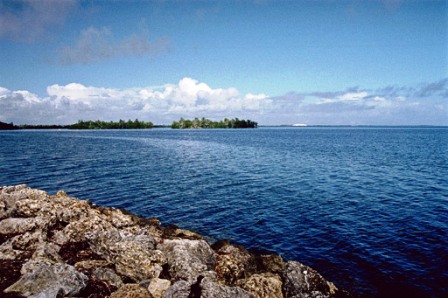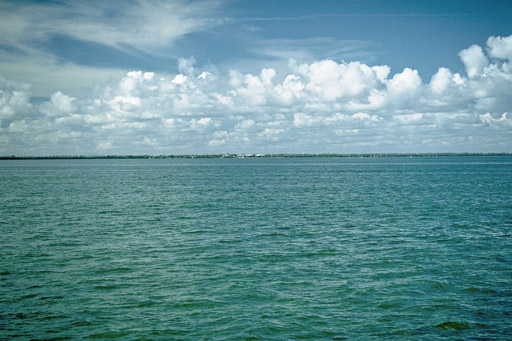Discover Florida Nature
It's time to explore the natural Florida


|
|
|
|
|
 Biscayne
National Park is a U.S. National Park located in southern Florida, due
east of Homestead. The park preserves Biscayne Bay, one of the top scuba
diving areas in the United States. Ninety-five percent of the park is
water. In addition, the shore of the bay is the location of an extensive
mangrove forest. This
oceanic expanse of 175,000 acres encompasses the keys and living coral
reefs of Southern Biscayne Bay and is one of the largest marine
preserves in the United States. The waters are turquoise and crystal
clear, making it ideal for fishing, boating, snorkeling, scuba diving,
and marine gazing in general! This park, only 30 miles from downtown
Miami, contains the longest undeveloped
shoreline on Florida's east coast.
The main portion of the park on the mainland is at Convoy Point
approximately 10 miles west of Homestead, Florida. This section of the
park contains a picnic area. It also contains a boat dock for trips out
onto the bay, a visitor's center, and other visitor's services Biscayne
National Park is a U.S. National Park located in southern Florida, due
east of Homestead. The park preserves Biscayne Bay, one of the top scuba
diving areas in the United States. Ninety-five percent of the park is
water. In addition, the shore of the bay is the location of an extensive
mangrove forest. This
oceanic expanse of 175,000 acres encompasses the keys and living coral
reefs of Southern Biscayne Bay and is one of the largest marine
preserves in the United States. The waters are turquoise and crystal
clear, making it ideal for fishing, boating, snorkeling, scuba diving,
and marine gazing in general! This park, only 30 miles from downtown
Miami, contains the longest undeveloped
shoreline on Florida's east coast.
The main portion of the park on the mainland is at Convoy Point
approximately 10 miles west of Homestead, Florida. This section of the
park contains a picnic area. It also contains a boat dock for trips out
onto the bay, a visitor's center, and other visitor's servicesThe obvious way to explore this water paradise is by boat. Visitors can launch their own at Convoy Point, the mainland information center, or take one of the tours arranged there. A ninety minute excursion in a glass- bottomed boat along the mangrove fringed shoreline gives you a colorful view of the grassy seabed and the shrimp, lobsters, green turtles, hawksbill turtles, sponges, and exotic tropical fish lurking there. Biscayne National Park is a very diverse place. Four distinct ecosystems melt into one another creating rich edge communities, or "ecotones." These edges support an incredible array of wildlife, including hundreds of species of colorful fish, and plants found nowhere else in the United States, along with visitor favorites like pelicans, manatees and turtles. Winds, currents, storms and the park's close proximity to one of the nation's largest urban areas means that the entire park is in a constant state of flux — ever-changing in the face of new challenges posed by the constant cycle of building and destruction.  Elliott
Key, the park's largest island, is considered the first of the true
Florida Keys being formed from fossilized coral reef, known as Key Largo
limestone. The islands farther north in the park are transitional
islands of coral and sand. To savor the special appeal of a sub-tropical
island, you can take a 50 foot excursion boat to Elliott Key seven miles
offshore. The attractions here include a small swimming beach on the
ocean side and the chance to snorkel or dive around
living coral reefs.
Visitors can enjoy the designated swim area located on the bay side of
the island (just to the north of the harbor). The shoreline of the
island is generally rocky, so shoes are recommended at all times
to protect feet. You can also stroll a boardwalk on a 1 1/2 mile nature
trail through
hammock and linger
to enjoy an island sunset. Fishing is permitted from the maintenance
dock located south of the harbor or from the shoreline outside of the
buoyed swimming area and no-wake zone. Elliott
Key, the park's largest island, is considered the first of the true
Florida Keys being formed from fossilized coral reef, known as Key Largo
limestone. The islands farther north in the park are transitional
islands of coral and sand. To savor the special appeal of a sub-tropical
island, you can take a 50 foot excursion boat to Elliott Key seven miles
offshore. The attractions here include a small swimming beach on the
ocean side and the chance to snorkel or dive around
living coral reefs.
Visitors can enjoy the designated swim area located on the bay side of
the island (just to the north of the harbor). The shoreline of the
island is generally rocky, so shoes are recommended at all times
to protect feet. You can also stroll a boardwalk on a 1 1/2 mile nature
trail through
hammock and linger
to enjoy an island sunset. Fishing is permitted from the maintenance
dock located south of the harbor or from the shoreline outside of the
buoyed swimming area and no-wake zone.Elliott Key was used on a transient basis for millennia by Tequesta Indians, and later by fishermen and wreckers from the Bahamas and the lower Florida Keys. The earlier name for the key was Ledbury Key, named after a ship that was driven ashore in 1760. There are legends of Elliott Key and adjacent keys being used as a refuge by pirates and escaped slaves. The chief pirate of legend is Black Caesar, who is said to have escaped from a slave ship, and used Elliott Key as his base. The key was inhabited and the site of pineapple plantations in the latter part of the 19th Century and the first half of the 20th Century. In 1910 there were more than a dozen families raising pineapples on Elliott Key where an average crop was 50,000 to 75,000 dozen fruits, mostly sent by schooner to New York. |
|
|
Biscayne National Park Florida
Biscayne National Park is a U.S. National Park located in southern Florida, due east of Homestead. The park preserves Biscayne Bay, one of the top scuba diving areas in the United States. Ninety-five percent of the park is water.
Visitors can launch their boat at Convoy Point, the mainland information center, or take one of the tours arranged there. A ninety minute excursion in a glass- bottomed boat along the mangrove fringed shoreline gives you a colorful view of the grassy seabed and the shrimp, lobsters, green turtles, hawksbill turtles, sponges, and exotic tropical fish lurking there. Floridian nature is diverse here with 4 distinct ecosystems melting into one another creating rich edge communities, or "ecotones." Biscayne National Park is truly Floridian nature at its best!
Written by: Brenda Arnold
Biscayne National Park
Date published: 10/22/2013
4 / 5 stars
|
|